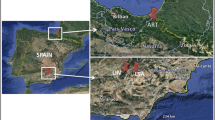Abstract
Since trees record all the environmental factors in the wood, many wood properties are related to the site characteristics. Despite of this fact, identifying the origin of a timber has always been considered a difficult task, and no effective tools are presently available for this purpose. The goal of this study was to verify whether significant differences among groups of the same wood species due to the provenance can be detected with Fourier transform near-infra-red spectroscopy (FT-NIR). Spruce (Picea abies L. Karst.) samples collected from stands in Finland, Northern and Southern Poland and Italy were analyzed using two different approaches: for the first approach samples were collected from four provenances scattered in a wide area throughout Europe, while for the second approach the samples were collected from provenances located in a narrow area within the same region in Italy. For the first approach, all the specimens were clearly divided into groups by using statistical methods. The separation among groups from the narrow local area was actual; even though less significant than in the previous case. It was concluded that trees growing in various locations have somewhat different chemical composition, and FT-NIR is sensitive enough to detect such differences. The presented method could be used for tracking wood provenances and as a technical tool for detecting logs harvested illegally from protected areas.






Similar content being viewed by others
References
Agarwal UP, Kawai N (2005) “Self-absorption” phenomenon in near-infrared Fourier transform Raman spectroscopy of cellulosic and lignocellulosic materials. Appl Spectrosc 59(3):385–388
Andreassen K, Solberg S, Tveito OE, Lystad SL (2006) Regional differences in climatic responses of Norway spruce (Picea abies L. Karst) growth in Norway. For Ecol Manag 222:211–221
Antti H (1999) Multivariate characterization of wood related materials. PhD Thesis, Umeå University
Brunner M, Eugster R, Trenka E, Bergamin-Strotz L (1996) FT-NIR spectroscopy and wood identification. Holzforschung 50:130–134
Coates J (2000) Interpretation of infrared spectra, a practical approach. Encyclopedia of analytical chemistry. John Wiley & Sons Ltd, Chichester, pp 10815–10837
Darwin C (1868) The variation of animals and plants under domestication, vol 1. Murray, London
Gierlinger N, Schwanninger M, Wimmer R (2004) Characteristics and classification of Fourier-transform near infrared spectra of the heartwood of different larch species (Larix sp.). J Near Infrared Spectrosc 12:113–119
Krzysik F (1978) Nauka o drewnie. PWN, Warszawa (in Polish)
Manetti MC, Cutini A (2006) Tree-ring growth of Silver fir (Abies alba Mill.) in two stands under different silvicultural systems in central Italy. Dendrochronologia 23:145–150
Miina J (2000) Dependence of tree-ring, earlywood and latewood indices of Scots pine and Norway spruce on climatic factors in eastern Finland. Ecol Model 132:259–273
Miranda I, Pereira H (2002) Variation of pulpwood quality with provenances and site in Eucalyptus globus. Ann For Sci 59:283–291
Niemz P, Wienhaus O, Schaarschmidt K, Ramin R (1989) Untersuchungen zur Holzartendifferenzierung mit Hilfe der Infrarot-Spektroskopie. Holzforsch. Holzverwert 2:22–26
OPUS Reference manual (2004) Bruker Optic GmbH
Park YI, Spicker H (2005) Variation in the tree-ring structure of Norway spruce (Picea abies) under contrasting climates. Dendrochronologia 23:93–104
Pasquini C (2003) Near infrared spectroscopy: fundamentals, practical aspects and analytical applications. J Braz Chem Soc 14(2):198–219
Rana R, Müller G, Naumann A, Polle A (2008) Evaluation of the FTIR spectroscopy in combination with principal components analysis (PCA) or cluster analysis as a tool to distinguish beech (Fagus silvatica L.) trees grown at different sites. Holzforschung 62(5):530–538
Schimleck LR, Michell AJ, Vinden P (1996) Eucalypt wood classification by NIR spectroscopy and principal components. Appita J 49(5):319–324
Skrøppa T, Hylen G, Dietrichson J (1999) Relationship between wood density components and juvenile height growth and growth rhythm trials for Norway spruce provenances and families. Silvae Genetica 48(5):235–239
Smith RH, Peloquin RL, Passoff PC (1969) Local and regional variation in the monoterpenes of ponderosa pine wood oleoresin. U.S.D.A Forest Serv Res Paper PSW-56
Spicker H (2000) Growth of Norway spruce (Picea abies [L.] Karst.) under changing environmental conditions in Europe. EFI Proceedings No. 33:11–26
Tahar D, Tayeb B, Chaabane C (2007) Essential oil composition of Pinus halepensis Mill. from three different regions in Algeria. J Essent Oil Res 1–2:1–5
Tsuchikawa S (2007) A review of recent near infrared research for wood and paper. Appl Spectrosc Rev 42:43–71
Tsuchikawa S, Inoue K, Noma J, Hayashi K (2003a) Application of near-infrared spectroscopy to wood discrimination. J Wood Sci 49:29–35
Tsuchikawa S, Yamato K, Inoue K (2003b) Discriminant analysis of wood based materials using near-infrared spectroscopy. J Wood Sci 49:275–280
Tsuchikawa S, Yonenobu H, Siesler HW (2005) Near-infrared spectroscopic observation of the ageing process in archeological wood using deuterium exchange method. Anal 130:379–384
Via BK, Shupe TF, Groom LH, Stine M, So CL (2003) Multivariate modeling of density, strength and stiffness from near infrared spectra for mature, juvenile and pith wood of longleaf pine (Pinus palustris). J Near Infrared Spectrosc 11:365–378
Ward JH (1963) Hierarchical grouping to optimize an objective function. J Am Stat Assoc 58(301):236–244
Wienhaus O, Niemz P, Fabian J (1988) Untersuchungen zur Holzartendifferenzierung mit Hilfe der Infrarotspektroskopie. Holzforsch. Holzverwert 40(6):120–125
Workman J, Weyer L (2007) Practical guide to interpretive near-infrared spectroscopy. CRC Press, Boca Raton
Xu L, Zhou YP, Tang LJ, Wu HL, Jiang JH, Shen GL, Yu RQ (2008) Ensemble preprocessing of near infrared (NIR) spectra for multivariate calibration. Analitica Chimica Acta 616:138–142
Acknowledgments
The authors would like to gratefully acknowledge Fondazione Cassa di Risparmio di Trento e Rovereto, who provided partial support for this research. Special thanks to Dr Henrik Heräjärvi of METLA, Finish Forest Research Institute, for providing samples from Scandinavia, and to all foresters who helped with the collection of the research specimens. Finally, we would like to appreciate Professor Lech Muszynski, Oregon State University for his assistance.
Author information
Authors and Affiliations
Corresponding author
Rights and permissions
About this article
Cite this article
Sandak, A., Sandak, J. & Negri, M. Relationship between near-infrared (NIR) spectra and the geographical provenance of timber. Wood Sci Technol 45, 35–48 (2011). https://doi.org/10.1007/s00226-010-0313-y
Received:
Published:
Issue Date:
DOI: https://doi.org/10.1007/s00226-010-0313-y




